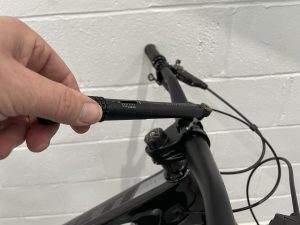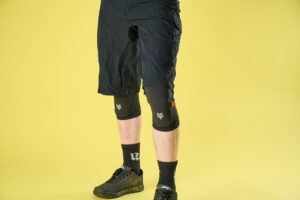Designed around the compact Shimano EP8 motor, the aptly named Megawatt shares a strikingly similar profile, right down to the counter- rotating four-bar suspension, with the acoustic version that has racked up three consecutive EWS World Championship titles.
Nukeproof Megawatt 297 Factory (2021) review
Think Nukeproof and the iconic race that is the Megavalanche instantly springs to mind, it’s fitting then that their first e-bike – the Nukeproof Megawatt – is based on its most successful platform to date, the Mega.
The most obvious departure from the acoustic Nukeproof Mega is the oversized down tube that houses the 630Wh Shimano battery, enough juice to summit Alpe d’hues without having to set foot in a cable car. And just so there’s no confusion over Nukeproof’s preferred wheel size, the Megawatt sports a 297 tag in the model name, indicating that it’s running a 29in wheel up front and 27.5in out back. And while a lot of best electric mountain bike manufacturers use fatter tyres on the rear, Nukeproof has gone with a regular 2.4in-width rear tyre.

Nukeproof Megawatt 297 Factory review
Nukeproof Megawatt review
Built from aluminium, the Megawatt frame isn’t as easy on the eye as the full-carbon YT Decoy, nor is it as light – the top-end Megawatt Factory in size large tips the scales at 24.37kg (53.76lb), more than one kilogram heavier than the YT Decoy. It’s not a fair comparison, though, as the Nukeproof comes shod with thicker casing, more durable DoubleDown Maxxis tyres and a bigger, heavier battery. So while carbon construction can save approximately 500g in frame weight, on e-bikes its use is much more about aesthetics than weight saving or strength.
Available in five frame sizes, with the size large sitting squarely in the middle, it’s fair to say that Nukepoof has nailed the fit on the Megawatt. Thankfully it’s also nailed the geometry, as there are no geometry-adjustable features on this bike, not even a flip-chip. And while all frame sizes share the same rear ends and 440mm chainstay length, as you go up through the frame sizes the seat angles steepen, so taller riders won’t be sitting way behind the rear axle on steep climbs.
There a re currently three models in the Megawatt range, where the Elite and Factory both run Fox 38 forks with standard 1.5in tapered steerer tubes. The entry-level Comp switches things up with the RockShox Zeb and the latest oversized 1.8in tapered steerer tube. All of the frames are the same, so you’re future-proofed against changing fork standards, but the real reason for the oversized head tube is that it allows all the cables to run into the frame through the Acros headset. Thankfully we had no issue getting the handlebar low enough on the Megawatt, as one downside of this integrated approach is that you can’t fully slam the stem onto the headset.

Suspension travel comes up 10mm short but feels super-supple thanks to shock-link bearings
Suspension
Travel on the Megawatt is listed as 170mm front and rear, and while that’s true of the Fox 38 Factory fork, we measured vertical rear-wheel travel at 160mm. Not that you notice any shortcomings. In fact, it’s the rear suspension on the Megawatt that masks the bike’s weight. It’s poppy, really sensitive off the top, thanks in part to bearings at the shock/link interface, and because it’s floaty in the mid-stroke, it is really easy to preload the suspension and ride light over roots and rocks. If you want a tighter, flatter suspension response, cranking up the independent high and low-speed compression damping on the Fox Float X2 shock will allow you to do just that.

Shimano EP8 motor is powered by a 630Wh battery
Components
One look at the down tube and it’s obvious that stiffness isn’t an issue on the Megawatt, so just like the analogue bikes, Nukeproof shuns the oversized 35mm bar/stem standard in favour of a regular 31.8mm option. The in-house alloy handlebar had a nice profile and the 50mm stem complements the proportions of the frame and the steering geometry perfectly.
With a full XT drivetrain, the shifting on the Megawatt is first-rate. And because acceleration on any e-bike is rapid, the XT shifter’s ability to drop down through the 12-speed cassette two gears at a time is a real boon. We also like the pinch-bolt design of Shimano’s HollowTech crankarms, as they are less prone to working loose than the old ISIS spline designs favoured by most other motor manufacturers. Yes, the XT brakes can feel grabby and have been plagued with bleed issues, but there is no disputing their stopping power and the brakes on the Megawatt were 100% consistent. If we could change one thing on the Megawatt it would be the tyres, but not the casings. We’d much prefer a battery-sparing MaxxTerra-compound Assegai up front and a Minion DHR II tread pattern on the rear, as the centre knobs have more support and don’t wear out as fast as the High Roller II.

Compact colour display unit is both easy on the eye and easy to use
Performance
We love the low BB height on the Megawatt, and while it does make timing pedal strokes more tricky on technical ups, it really lets you open up the taps on techy descents and find flow where other e-bikes falter. There are advantages to the relatively short rear end on the Megawatt too, as it helps shift the weight bias more rearward, which in turn offsets the high/forward position of the 630Wh battery, again improving handling. And as batteries get bigger and motors continue to shrink, we think shorter rear ends will become even more prevalent as they make full-powered e-bikes that much easier to manoeuvre. But what about climbing? Sure, the Megawatt won’t win any hill-climb challenges, but the relatively steep seat angle ensures that you are in a good seated position for grinding up the steepest of gradients, even if the bike’s focus is clearly fixed on hammering the descents.

Nukeproof Megawatt 297 Factory
Verdict
First-time lucky? No... Chance had nothing to do with Nukeproof’s successful launch of the Megawatt. By sticking to the fundamentals of bike design and focusing on ride quality, Nukeproof has supercharged the Mega and delivered an e-bike that’s every bit as capable as it is fun to ride. And while £7K is still a stack of cash for an alloy e-bike, compared to what you get from the likes of Specialized, there’s no arguing that even the flagship Megawatt Factory-level build represents superb value for money from a bricks and mortar brand.
















